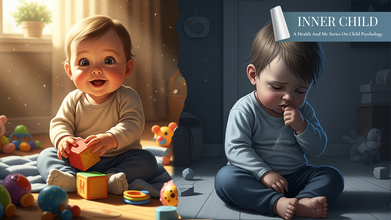- Health Conditions A-Z
- Health & Wellness
- Nutrition
- Fitness
- Health News
- Ayurveda
- Videos
- Medicine A-Z
- Parenting
- Web Stories
Raising Kids in the Digital Age: A Mindful Guide to Screens, Balance, and Wellbeing

Credits: Canva
Your child’s first words might not be “Mama” or “Papa” but “Wi-Fi.” Welcome to parenthood in the age of glowing screens, where nursery rhymes play on tablets and bedtime stories compete with YouTube shorts. Technology is not the problem, nor is it the giving of endless wisdom. It is simply a tool, and like any tool, it depends on how you use it.
Experts say it is not about scaring children away from digital spaces but teaching them to wander through it with mindfulness. “Parents do not need to be strict gatekeepers or blind cheerleaders; instead, walk alongside your child with awareness, empathy, and clarity,” advises Dr Rahul Chandhok, Sr Consultant and Head of Psychiatry, Artemis Lite, New Delhi. That way, children learn to stay rooted in themselves while embracing technology in healthier ways.
Start with Awareness, Not Fear
It is tempting to label the internet as dangerous and unpredictable, but starting with fear only fuels curiosity. “Don’t tell your child that the digital world is unsafe. Instead, help them understand that it’s a tool, a powerful one, that can be used for growth, learning, and creativity,” says Dr Chandhok.
So instead of saying, “Put that phone down!” try saying, “What are you watching? What do you like about it?” These conversations show children you are interested, not policing. It also opens doors to explaining the difference between meaningful use and mindless scrolling.
Create a Safe Digital Space
Your child’s online world should feel as safe as their bedroom. Setting age-appropriate boundaries matters, but involve them in the rule-making. “When children feel like they helped create the rules, they are more likely to follow them,” says Dr Chandhok.
So the next time you are laying down screen-time rules, do not just declare, “No gadgets after 9 pm.” Instead, ask, “How do you feel after playing late at night?” This collaborative approach makes rules less about control and more about care.
Model Mindful Use
Remember, kids don’t listen; they watch. “Children absorb far more from what they see than what they’re told,” says Dr Chandhok. If your nose is buried in your phone at the dinner table while telling them to “limit screen time”, they will catch the contradiction instantly.
Show them that breaks are normal. Put your phone down during meals. Dedicate “tech-free” hours in the day. Streamline your online activity into purposeful chunks. These small acts become silent lessons your child absorbs without argument.
Teach Emotional Awareness
Screens trigger emotions in ways children may not fully understand. Before and after screen time, Dr Chandhok suggests asking them to pause and check in with themselves: Do they feel calm, restless, happy, or tense? This simple habit of noticing their own emotions helps children regulate usage without needing an adult to intervene.
It also teaches them something powerful—that they are in charge of their relationship with technology, not the other way around.
Encourage Offline Joy
Even the most immersive online game can’t replace the messy joy of chasing a ball or the quiet thrill of finishing a jigsaw puzzle. “The brain in childhood is constantly adapting. Too much screen time, especially fast-moving, stimulating content, can make it harder for children to concentrate and manage emotions,” explains Dr Utkarsh Bhagat, Senior Consultant and Director, Neurosurgery.
This is where “digital nutrition” comes in. Just as a balanced diet includes fruits and veggies along with the occasional treat, screen use should balance with non-digital joys, like board games, drawing, playing outdoors, or simply sitting around and laughing together.
Nurture Digital Compassion
The digital world can feel like a giant popularity contest of likes, followers, and comments. Children need to be taught that their self-worth is not a scoreboard. “Encourage them to communicate respectfully online and avoid comparisons,” says Dr Chandhok. This not only protects their self-esteem but also builds empathy and kindness towards others.
Helping your child understand that their value lies beyond the virtual applause strengthens their emotional resilience and prepares them to handle criticism, online or offline, with confidence.
Boundaries That Protect, Not Punish
Dr Bhagat points out that boundaries are not walls but gentle guardrails. “Creating screen-free times, such as during meals or before bed, makes a big difference,” he says. Sleep, for instance, is non-negotiable for memory and wellbeing, yet late-night scrolling can wreck it.
When boundaries are explained as supportive rather than restrictive, children see them less as punishments and more as protections.
Lead by Example
At the end of the day, parenting in the digital world boils down to modelling balance. “Children learn by watching their parents,” stresses Dr Bhagat. If you binge-scroll Instagram at midnight, chances are your child will do the same someday. If you show them that offline activities like cooking, reading, or simply going for a walk are fulfilling, they will follow.
The digital future is here to stay. But your child’s mind is still beautifully, tenderly human. With mindful guidance, awareness, and a touch of quirky balance, you can help them thrive in both worlds. As Dr Bhagat sums up, “Technology is not the enemy here; balance is the key.”
Inner Child: Emotional Neglect, Not Just Abuse, Can Scar A Child For Life

Credits: Health and me
Inner Child is Health and Me's new mental health series where we deep dive into lesser-known aspects of child psychology and how it shapes you as you grow up. Often unheard, mistaken, and misunderstood, in this series we talk about the children’s perspective and their mental health, something different than you might have read in your parenting books. After all, parenting is not just about teaching but also unlearning.
Child development is often measured by milestones: first steps, first words, first day of school. Yet beneath these visible markers is a much deeper foundation that is far less obvious but far more critical- emotional security. A child might be fed, dressed, and protected, but still struggle if the critical attachment of responsive care is lacking. How does a lack of attention, affection, or regular emotional support influence a child's brain, behavior, and lifelong mental health?
Think of two children in vastly different environments. One is immersed in play, exploring new objects with curiosity and assurance, absorbed in discovery and learning. The other, raised without consistent emotional connection, may hesitate, withdraw, or even appear disinterested, despite having all physical needs met. These differences highlight an even deep reality- emotional abandonment—subtle, quiet, and easily invisible, can leave wounds as deep as overt cruelty. Learning about these effects is important not just for parents and caregivers, but also for educators, policymakers, and anyone who cares about helping resilient, healthy children.
When we talk of child development, the first thing that comes to mind is usually physical care- food, hygiene, shelter. But as decades of psychological research show, these essentials are insufficient in a child's emotional life, the feeling of security, responsiveness, and attachment is equally as important. Emotional neglect, even without overt abuse, can produce long-lasting, deep scars on a child's brain, behavior, and social-emotional development.
Child Development: Role of a Nurturing Environment
Kids brought up under supportive family environments have remarkably distinct behaviors from those bereft of emotional nurturing. Emmanuel, for instance, is one brought up in a safe and responsive family. The world is explored by him with fearless wonder. When presented with a new object, he investigates it meticulously, shifting it from hand to hand, even taking it to his mouth to comprehend its sensation. He is completely absorbed in the process, indifferent to the people around him.
In the same way, Christine, who participates daily in a nurturing nursery setting, handles objects deliberately, inquisitively. She places blocks on top of each other, retrieves them when they tumble, and is completely engaged in the activity. Both children illustrate how safety, focus, and warmth promote curiosity, learning, and confidence.
These are just a few of the examples that are a demonstration of what psychologists call emotional safety—the safe base that enables a child to concentrate, play, and learn without constantly having to guard against psychological harm.
When Emotional Neglect Interrupts Development in Babies
The profile is altered radically in youngsters with emotional neglect or who are taken away from home because of dangerous conditions. Caroline, who has been the victim of maternal neglect, shows very little interest in playing. She touches a block fleetingly but promptly becomes distracted, glancing about the room and the adults in the room. Her interest is fleeting, her curiosity dampened.
Veronique, a second child in an environment of emotional deprivation, shows avoidance behaviors, raising her arms to exclude contact and showing anxiety during object-handling. Jean, taken away from several placements and institutionalized, maintains intense focus on the psychologist's movement instead of investigating his environment. This is a vital psychological development: emotionally deprived children will turn social contact into a replacement for maternal interaction often at the cost of learning or curiosity.
Annette and René mirror one another's withdrawal patterns. René remains still, later trying to engage with objects but beset by fright, then retreating to thumb-sucking as a self-calming activity. Annette, completely uninterested in her environment, manifests physiological distress, from abnormal breathing to twitching lips. Colette, a similarly emotionally starved child, manifests autism-like symptoms and increased anxiety, staying rigid with labored breathing and glazed expression.
These behaviors are not discrete incidents—they represent a larger, troubling trend. Neglect of emotions stifles a child's sense of exploration, curiosity, and wonder about the world. In extreme cases, it may even lead to symptoms of autism spectrum disorders.
How to Become Better Parents?
The consequences of emotional neglect have been around for a while. In the 1940s, psychoanalyst René Spitz did some path-breaking research on institution-reared babies who did not have regular caregivers. Spitz found that when fundamental physical needs such as food and diapers were provided, infants showed stunning developmental problems: loss of interest, delayed development, vacant stares, immobility, and shutting off from emotions.
Spitz's research proved a basic truth: infant development hinges on attachment, not only on nurturing. Without responsive care, an infant's brain changes from discovery to self-defense. Play, learning, and interaction give way to watchfulness, apprehension, and withdrawal.
What Is Emotional Neglect?
Unlike physical abuse, emotional neglect can be out of sight. Parents or caregivers can give a child whatever they need in terms of material goods but not give responsive attention, affection, or validation. Neuroscientifically, this neglect impacts the developing brain in complex and lasting ways. Neural circuits used for emotion regulation, stress response, and social engagement are impaired, making children more susceptible to anxiety, depression, and social withdrawal as adults.
Psychologists insist that responsive parenting is not spoilage. Offering connection, attention, and emotional resonance does not produce "spoiled" kids. Instead, it shields babies from premature shutdown, fostering healthy brain development before they even have words to articulate their needs.
How Emotional Neglect Reflects And Impacts Children?
Emotional neglect has long-reaching consequences for a child's lifetime. Lowered curiosity, restricted exploration, and increased anxiety in early childhood may mean trouble with learning, relational connections, and stress management during adolescence and adulthood. Children lacking steady emotional support are at risk of mental health disorders, such as depression, anxiety disorders, and emotion regulation difficulties.
From a public health standpoint, these results underscore the need for early intervention, awareness, and parenting support programs. Having caregivers who can provide emotional responsiveness can help mitigate the long-term effects of neglect and encourage healthier developmental paths.
How Can Parents Create Emotional Safety?
It is not difficult to create emotionally safe spaces, but it does take intentionality. Practices suggested by psychologists include:
Engaging in attentive and consistent interaction with the child.
- Validation of the child's experience and feeling.
- Gentle redirection instead of punitive reactions to exploring or making errors.
- Chances for discovery and free play in a safe context.
- Even small, consistent acts of responsiveness can have a significant impact on a child's emotional and intellectual development.
- Emotional neglect is no less harmful, if not more subtle, than physical abuse. Children denied predictable care and attention might live on, but brains and emotional lives suffer dearly. Caroline's, Veronique's, René's, Annette's, and Colette's histories demonstrate the severe consequences of neglect: anxiety, withdrawal, stifled curiosity, and in extreme circumstances, autistic-like behaviors.
What these studies reveal is that child development starts with attachment. Responsive parenting is not a choice, but a necessity. It creates the safety children require to experiment, learn, and develop into strong, capable individuals. Simply put, emotional safety isn't a nicety, but a requirement for mental and emotional well-being for a lifetime.
Doctors Warn of Rising Congenital Syphilis After 3 Babies Died In New York, Are Missed Screenings To Blame?

Credits: iStock
Health officials across the United States are sounding an urgent alarm and a warning about congenital syphilis, a previously uncommon reason for infant mortality, continues its upswing. In 2023, the Centers for Disease Control and Prevention (CDC) reported 3,882 cases, the most since 1992. In 1992 alone, 279 babies died from the infection or were delivered stillborn, with 252 of them listed as stillbirths—a 6.3 percent rise from 2022.
The country's congenital syphilis rate is currently 105.8 cases per 100,000 live births, a three percent rise from last year. Experts cite the increase mainly due to loopholes in prenatal care, inadequate screening, and lacking follow-up treatment during pregnancy.
What Is Congenital Syphilis?
Syphilis is a sexually transmitted disease produced by the bacterium Treponema pallidum. The primary signs are sores in the location of infection, usually the genitals or mouth, whereas secondary syphilis may present with rashes on hands and feet.
Congenital syphilis takes place if a pregnant mother passes the disease to her unborn child, which might lead to severe complications. These may involve bone abnormalities, jaundice, skin rashes, neurological complications, and even in extreme cases, stillbirth or death of the infant. According to the World Health Organization, 1.5 million cases of congenital syphilis are estimated worldwide each year.
Fortunately, syphilis and congenital syphilis are preventable using condoms and can be treated using penicillin. Unattended cases, however, have disastrous and permanent effects.
What Is Behind The Spike In Congenital Syphilis?
Evidence indicates that much of congenital syphilis is a result of failed screenings and untreated infections. Across the country, 43 percent of birth parents were not screened for syphilis during pregnancy, and 23 percent of the infected were not treated. Gaps in 2022 accounted for almost 90 percent of congenital syphilis.
Unscreened or untreated sexual partners further contribute to the issue. "Early detection is the key," asserts Dr. Jim Saperstone of Community Care Pediatrics. "Syphilis, if left untreated, can affect a newborn's brain, heart, eyesight, and development.
New York State has experienced an alarming increase in the number of cases, with three infant fatalities reported in 2025 and 21 cases outside of New York City to date this year. The city alone had 35 cases in 2023. In reaction, officials in New York are pushing for mandatory blood tests for expectant mothers.
"No baby should ever die from syphilis in New York State or in this nation," said State Health Commissioner Dr. James McDonald. He points out that early diagnosis by easy blood tests is key to quick treatment and healthy results.
Hotspots and national trends
Although New York is precarious, the most elevated rates of syphilis and congenital syphilis reside in states such as South Dakota, New Mexico, Mississippi, Arizona, and Texas. Such states have the highest rates per 100,000 live births, making them priority targets for public health initiatives.
The CDC states congenital syphilis cases can be prevented but are made difficult by structural issues like a shortage of prenatal care, reduced access to testing, and nationwide deficiencies in the specialized penicillin treatment. Pfizer, the only company producing the penicillin formulation given to pregnant women, already has a national shortage, leading officials to ration its availability for congenital cases.
Why Screening Is Equal Way Part Of Prevention?
Syphilis testing is universally recommended by every U.S. state in the first trimester, but the recommendations differ for third-trimester and post-birth periods. Eighteen states recommend testing in the third trimester, nine suggest testing after birth, while just eight require screenings at the time of delivery. Experts emphasize that early screening, regular follow-up, and compliance with treatment are the best methods to avoid congenital syphilis.
"Early involvement with healthcare providers is key," Dr. McDonald said. "Blood tests during the first trimester, again at 20–32 weeks, and close to delivery should be given to pregnant women. The use of condoms also decreases transmission risk."
Medical education and awareness
In response to increasing cases, the U.S. Department of Health and Human Services, Office on Women's Health, introduced a new continuing medical education (CME) course: "Syphilis and Congenital Syphilis on the Rise – How to Protect Your Patients." The course provides practicing physicians, nurses, and pharmacists with effective strategies for screening, diagnosis, and patient-centered care. Physicians learn how to put guideline-based recommendations into practice, recognize key screening opportunities, and deliver empathetic treatment to infected families.
The rise of congenital syphilis also points to gaps in public health infrastructure, especially in prenatal care and follow-up treatment. Though most cases can be prevented with screening and penicillin treatment, shortages and uneven test schedules expose many newborns to dangers.
Physicians and public health practitioners advise all pregnant women to visit their physician regularly for prenatal care, adhere to recommended testing schedules, and have their treatment completed if they are found to be infected. Sexual partners should also be tested and treated to avoid reinfection.
Punishing Your Children Could Be Harming Their Health: WHO

Credits: Canva
A new report from the World Health Organization (WHO) has shed light on a troubling reality: corporal punishment remains widespread and continues to cause serious harm to children’s health, learning, and overall development.
Despite global progress in child protection laws, millions of children still face physical punishment both at home and in schools.
The Alarming Numbers
Globally, an estimated 1.2 billion children between the ages of 0 and 18 are subjected to corporal punishment in their own homes each year. The data is stark. Across 58 countries, around 17% of children who had recently experienced corporal punishment reported being subjected to its most severe forms. These included being hit on the head, face, or ears, or being struck hard and repeatedly.
The practice varies greatly from country to country. Among children aged 2 to 14 years, self-reported rates by parents and caregivers showed a wide range. In Kazakhstan, about 30% admitted to using corporal punishment in the past month, while in Ukraine the number was 32%. At the higher end, the figures climb to 63% in Serbia, 64% in Sierra Leone, and 77% in Togo.
Also Read: Decoding Baby Cries: What Are They Really Saying?
Schools Are Not Exempt
The troubling reality does not end at home. Schools, where children are supposed to feel safe, are also common settings for corporal punishment. Across parts of Africa and Central America, roughly 70% of children face some form of physical punishment during their school years.
In contrast, the Western Pacific region reports lower rates, but still around one in four children experience it in educational settings.
No Benefits, Only Harm
Experts stress that corporal punishment offers no benefits for children, families, or societies. Etienne Krug, Director of the WHO Department for Health Determinants, Promotion and Prevention, emphasizes that the evidence is now overwhelming.
Corporal punishment places children at multiple risks without improving their behavior, development, or well-being. Instead, it undermines their growth and creates lasting damage.
Who Is Most at Risk?
The report, Corporal Punishment of Children: The Public Health Impact, points out that some groups of children are more vulnerable than others. Those with disabilities, children of parents who themselves experienced corporal punishment, and those whose parents struggle with mental health issues or substance abuse face higher risks.
Larger societal factors, including poverty, racism, and discrimination, also play a significant role in perpetuating the cycle of violence.
Long-Term Health and Developmental Consequences
The effects of corporal punishment are far-reaching. Beyond immediate injuries, it alters children’s biological responses. Repeated punishment has been linked to higher stress hormone levels and even changes in brain structure and function, which can hinder healthy growth.
In low- and middle-income countries, data show that children exposed to corporal punishment are 24% less likely to be developmentally on track compared to their peers.
The psychological impact is equally concerning. Anxiety, depression, low self-esteem, and emotional instability are commonly seen in children who endure such punishment. Unfortunately, these issues often continue into adulthood, contributing to higher rates of depression, substance abuse, and even suicide.
A Broader Impact on Society
The damage is not confined to individual children. On a societal level, corporal punishment can normalize violence.
Children who experience it are more likely to struggle in school, adopt aggressive behaviors, and as adults, engage in antisocial or criminal conduct. The ripple effects create a dangerous cycle of violence across generations.
Moving Beyond Legislation
While many countries have enacted laws banning corporal punishment, the practice persists. This shows that legislation alone is insufficient. WHO stresses that legal reforms must be paired with awareness campaigns, parental support programs, and training for teachers. Promoting positive, non-violent approaches to discipline is key to breaking this cycle.
© 2024 Bennett, Coleman & Company Limited

